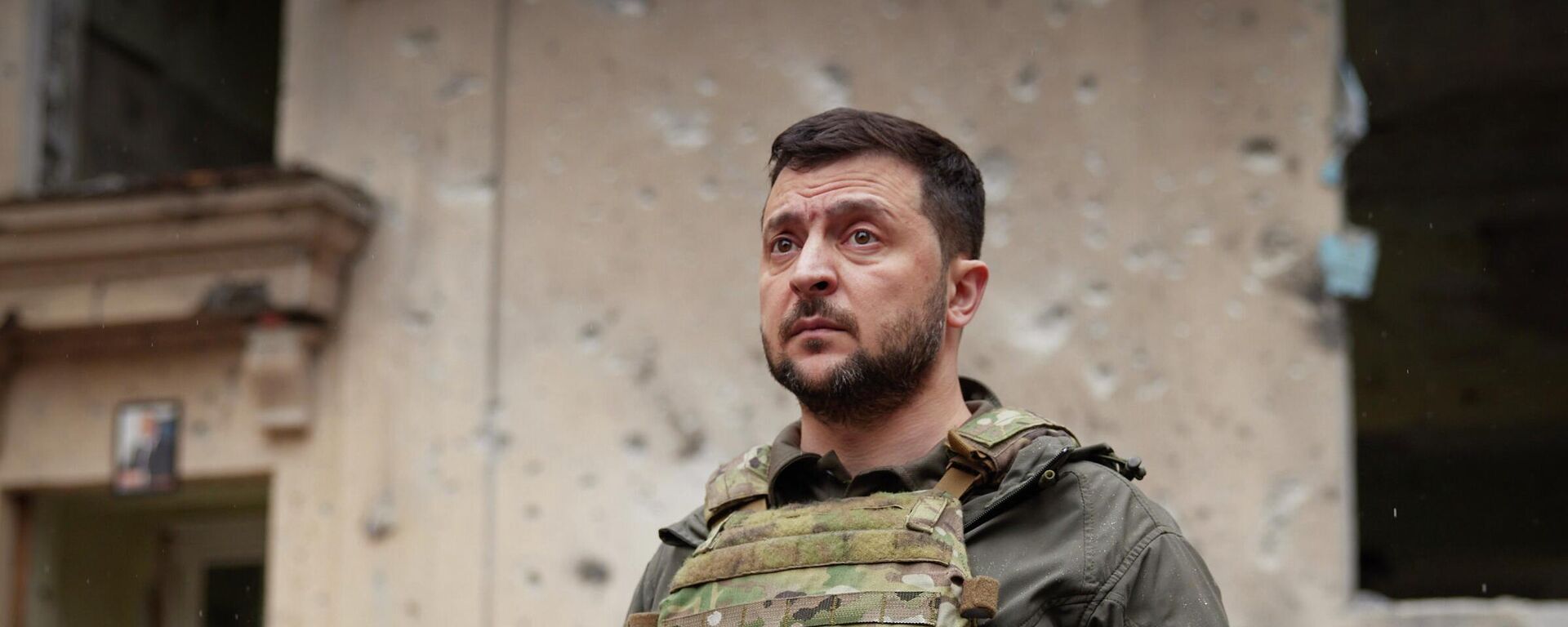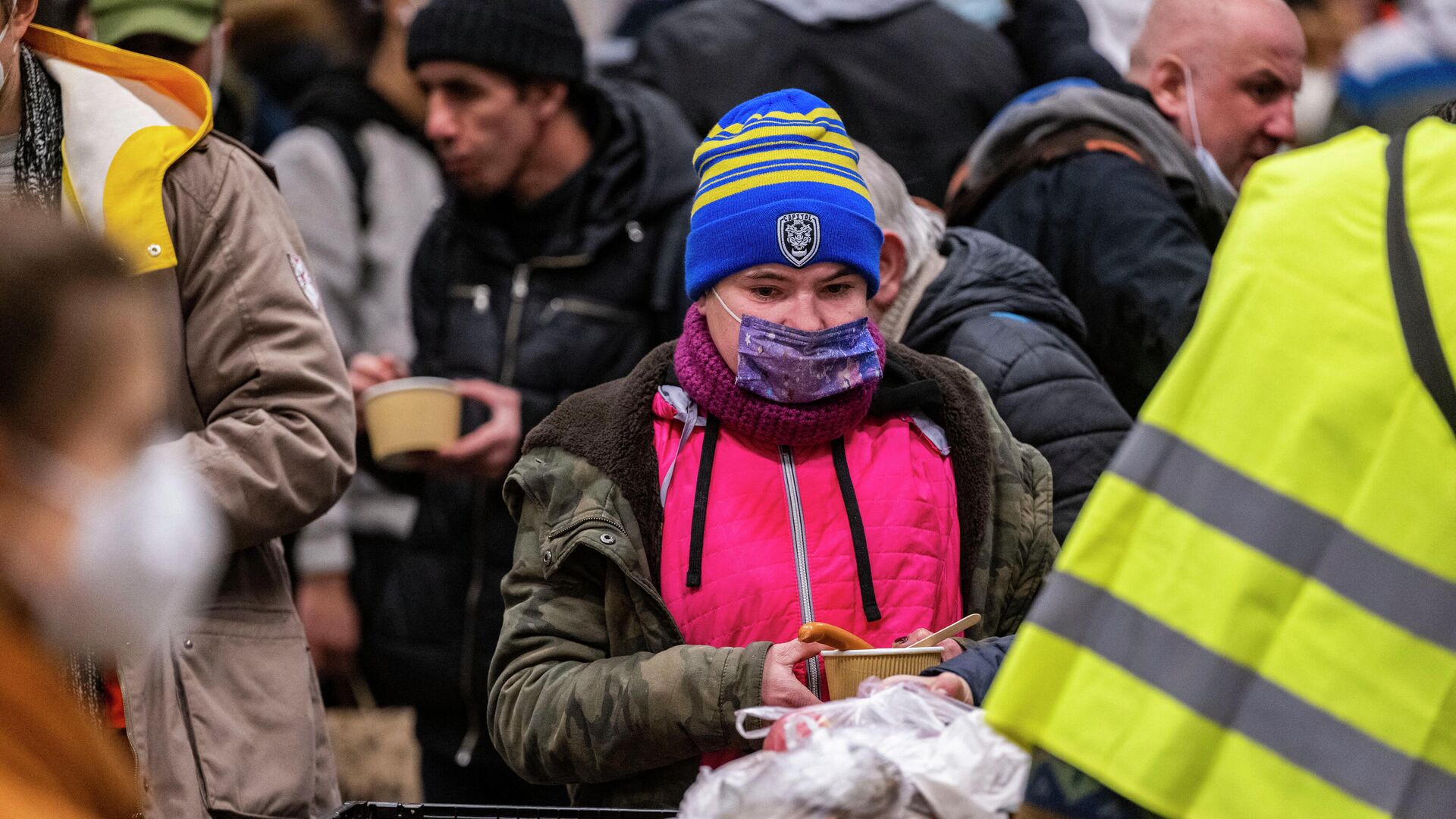https://sputnikglobe.com/20221122/why-is-west-eager-to-give-ukrainians-billions-worth-of-weapons-but-not-refugee-benefits-1104557861.html
Why is West Eager to Give Ukrainians Billions Worth of Weapons But Not Refugee Benefits?
Why is West Eager to Give Ukrainians Billions Worth of Weapons But Not Refugee Benefits?
Sputnik International
The British government is failing Ukrainian refugees with the Homes for Ukraine scheme now risking collapse, according to the UK press. However, the UK is not... 22.11.2022, Sputnik International
2022-11-22T17:41+0000
2022-11-22T17:41+0000
2023-02-09T11:45+0000
sputnik explains
us
europe
canada
refugees
ukraine
weapons
asylum seekers
cost of living
inflation
https://cdn1.img.sputnikglobe.com/img/07e6/03/0e/1093855623_0:0:3072:1728_1920x0_80_0_0_43c230b1b672e120b857dc3bc8cfee9c.jpg
The UK's 'Homes for Ukraine' scheme was drawn up with a six-month time limit, meaning that many Ukrainians who flee their country amid the Russian special military operation will be left without any support soon. British media has revealed that by mid-October, roughly a third of the displaced Ukrainian families in the country saw their hosting arrangements collapsing. Even though some British local authorities recognized the problem and provided deposits and the first month’s rent for displaced Ukrainians, others offered no assistance of any kind.The program – which housed over 100,000 Ukrainian nationals in the UK so far – has hit several bumps since it was inaugurated on March 14. UK-based refugee charity Positive Action in Housing raised the alarm as early as March 27, arguing that the government's guidelines were confusing and provided Ukrainians with "false hope." The newcomers had problems getting visas, while hundreds of families were left homeless in England after arriving despite being promised a place to live. With Ukrainian children being promised school places in the UK, many Ukrainian families waited for months for this to come through, being time and again denied entry to local educational institutions.The Ukraine Family scheme, kicked off by the British government for Ukrainian refugees and their families who have a family connection in the UK, could not boast much success either: a total of 1,915 Ukrainian households from both programs have become homeless between February and September 2022.The British media blames the hurdles on inadequate government funding, an inconsistent approach to accommodate Ukrainians at local levels, bureaucratic red tape, and the unfolding cost-of-living crisis in the UK. In August 2022, the Office for National Statistics (ONS) revealed that 21% of sponsors of the Homes for Ukraine program had complained that soaring inflation and the rising cost of living affected their ability to provide support for the scheme "quite a lot." Meanwhile, the UK press reported in mid-November that Chancellor Jeremy Hunt is considering reducing funding for the Homes for Ukraine scheme as inflation increases. The Consumer Prices Index - including owner occupiers' housing costs (CPIH) - jumped by 9.6% in the 12 months to October 2022, up from 8.8% in September 2022.European UnionNot everything is rosy in the garden of the EU's Ukraine refugee programs either.As of November 15, roughly 7.8 million Ukrainian refugees have been recorded across Europe with 4.7 million registering for EU Temporary Protection or similar national schemes, according to the United Nations High Commissioner for Refugees (UNHCR).The EU’s Temporary Protection program for Ukrainian refugees ensures the right to work, health, education, shelter, and financial support for up to three years. However, the western mainstream press acknowledges that the scheme has been far from a "golden ticket": many Ukrainian refugees had to move from place to place to secure employment, often to no avail. While Germany accommodated nearly one million Ukrainians between February and September, less than 10% of them have found jobs, according to the Federal Employment Agency. Likewise, Spain has taken in 142,000 Ukrainians under temporary protection, according to official figures, but only 13% of 90,000 Ukrainian refugees of working age have got jobs so far. The latest UNHCR survey conducted in 43 host nations, most of which are in Europe, indicated that just 28% of refugees were employed or self-employed. It has turned out that the fit between skill levels and jobs is highly problematic, while language requirements often become the major barrier.Schooling, child care and jobs for caretakers, as well as missing documents, housing, and human trafficking, are among other challenges faced by newcomers, according to observers.To cap it off, refugee fatigue has slowly started to engulf European populations amid galloping inflation and looming recession: volunteer help and donations have been on decline in Poland, Germany, the UK and elsewhere in Europe over the past months, western mainstream press admits.CanadaMeanwhile, across the pond in Canada, Ukrainians have also found themselves on the horns of a dilemma. In March, the Canadian federal government unveiled a special program called Canada-Ukraine Authorization for Emergency Travel (CUAET), which fast-tracks immigration for Ukrainians.However, Ottawa made it clear that the newcomers are not "refugees." Ukrainians coming in through the Canadian scheme are considered "temporary residents" who may work and study in the country for three years. However, unlike people with refugee status, they are neither offered permanent residency when they land nor social assistance (in some provinces). Moreover, Ukrainian "temporary residents" would have to pay international students fees if they want to get a higher education in Canada.Initially, Ukrainian newcomers did not even have any settlement support, which is typically provided to refugees by Ottawa. However, the program was later adjusted to provide a one-time package of $3,000 for adults and $1,500 per child under 18.According to the Canadian media, the scheme has prompted confusion. However, Aidan Strickland, press secretary for the Minister of Immigration, Refugees and Citizenship Canada, told press that it was the Ukrainian community who wanted "a temporary solution." Meanwhile, Ukrainians are complaining to the Canadian local press that they cannot make ends meet in the country: the cost of housing is proving to be one of the top issues for the newcomers, and it's very hard to get a job.The Canadian government website says that 689,854 CUAET applications were received between March 17 and November 15 with 420,196 applications being approved.United StatesThe US has taken fewer Ukrainian refugees (100,000) than any of the aforementioned blocs and – like its western peers – Washington is inclined to provide shelter to the newcomers from the Eastern European state on a temporary basis with no path for future citizenship.Earlier this year, the US federal government opened the Temporary Protected Status (TPS) program to Ukrainian nationals, which is valid for 18 months. According to the US government website, TPS is "a temporary benefit" that "does not lead to lawful permanent resident status or give any other immigration status."In addition, the Biden administration kicked off the Uniting for Ukraine (U4U) program on April 21, allowing Ukrainian nationals and their family members to come to the US via "private sponsorship" for an initial but renewable period of two years. The program requires a US-based sponsor to provide them with financial support during their stay in the country. Moreover, unlike the US Department of State’s Refugee Admissions Program (USRAP), the U4U does not provide Ukrainians with a pathway to citizenship, work authorization, or any possibility to reunite family members who remain abroad, let alone access to healthcare or other access to safety net programs.Judging from the small number of Ukrainian refugees who have been accommodated in the US so far, it's not an easy task for them to settle in the country. Indeed, some US immigration attorneys complain that the programs announced by the Biden administration have not provided any efficient solutions for Ukrainian refugees and keep them under stress that they will have nowhere to go once their temporary status expires.Nevertheless, the US and allies appear to be more than eager to provide Ukrainians with billions worth of lethal weapons rather than shelter, jobs and social benefits. The US, EU, UK and several other countries have generously committed a total of €41.5 billion in weapons to Kiev – which includes artillery, anti-aircraft and anti-tank arms, armored vehicles, reconnaissance and attack drones, helicopters, etc. – between January and October 2022, according to the Germany-based Kiel Institute for the World Economy. Given this, one might wonder whether the collective West is more interested in turning Ukrainians into cannon fodder than potential citizens.
https://sputnikglobe.com/20221111/we-have-had-enough-why-western-leaders-populations-call-for-halting-money-flow-to-ukraine-1104025789.html
https://sputnikglobe.com/20221031/end-of-the-lvov-affair-europe-tires-of-ukrainian-refugees--1102865634.html
https://sputnikglobe.com/20220928/no-home-no-money-ukrainian-refugee-who-seduced-her-host-in-uk-got-dumped-and-arrested-1101308739.html
canada
ukraine
Sputnik International
feedback@sputniknews.com
+74956456601
MIA „Rosiya Segodnya“
2022
News
en_EN
Sputnik International
feedback@sputniknews.com
+74956456601
MIA „Rosiya Segodnya“
Sputnik International
feedback@sputniknews.com
+74956456601
MIA „Rosiya Segodnya“
ukrainian refugees, asylum seekers, temporary resident, housing, cost of living crisis, homelessness, path to citizenship, unemployment
ukrainian refugees, asylum seekers, temporary resident, housing, cost of living crisis, homelessness, path to citizenship, unemployment
Why is West Eager to Give Ukrainians Billions Worth of Weapons But Not Refugee Benefits?
17:41 GMT 22.11.2022 (Updated: 11:45 GMT 09.02.2023) The British government is failing Ukrainian refugees with the Homes for Ukraine scheme now risking collapse, according to the UK press. However, the UK is not the only western country that has failed to deliver on its generous promises to Ukrainian asylum seekers while flooding Kiev with weapons.
The UK's 'Homes for Ukraine' scheme was drawn up with a six-month time limit, meaning that many Ukrainians who flee their country amid the Russian special military operation will be left without any support soon.
British media has revealed that by mid-October, roughly a third of the displaced Ukrainian families in the country saw their hosting arrangements collapsing. Even though some British local authorities recognized the problem and provided deposits and the first month’s rent for displaced Ukrainians, others offered no assistance of any kind.
The program – which housed over 100,000 Ukrainian nationals in the UK so far – has hit several bumps since it was inaugurated on March 14. UK-based refugee charity Positive Action in Housing raised the alarm as early as March 27, arguing that the government's guidelines were confusing and provided Ukrainians with "false hope."
The newcomers had problems getting visas, while hundreds of families were left homeless in England after arriving despite being promised a place to live. With Ukrainian children being promised school places in the UK, many Ukrainian families waited for months for this to come through, being time and again denied entry to local educational institutions.
The Ukraine Family scheme, kicked off by the British government for Ukrainian refugees and their families who have a family connection in the UK, could not boast much success either: a total of 1,915 Ukrainian households from both programs have become homeless between February and September 2022.
The British media blames the hurdles on inadequate government funding, an inconsistent approach to accommodate Ukrainians at local levels, bureaucratic red tape, and the unfolding cost-of-living crisis in the UK.
In August 2022, the Office for National Statistics (ONS) revealed that 21% of sponsors of the Homes for Ukraine program had complained that soaring inflation and the rising cost of living affected their ability to provide support for the scheme "quite a lot."
Meanwhile, the UK press reported in mid-November that Chancellor Jeremy Hunt is considering reducing funding for the Homes for Ukraine scheme as inflation increases. The Consumer Prices Index - including owner occupiers' housing costs (CPIH) - jumped by 9.6% in the 12 months to October 2022, up from 8.8% in September 2022.

11 November 2022, 14:25 GMT
Not everything is rosy in the garden of
the EU's Ukraine refugee programs either.
As of November 15, roughly 7.8 million Ukrainian refugees have been recorded across Europe with 4.7 million registering for EU Temporary Protection or similar national schemes, according to the United Nations High Commissioner for Refugees (UNHCR).
The EU’s Temporary Protection program for Ukrainian refugees
ensures the right to work, health, education, shelter, and financial support for up to three years. However, the western mainstream press acknowledges that the scheme has been far from a "golden ticket": many Ukrainian refugees had to move from place to place to secure employment, often to no avail.
While Germany accommodated nearly one million Ukrainians between February and September, less than 10% of them have found jobs, according to the Federal Employment Agency. Likewise, Spain has taken in 142,000 Ukrainians under temporary protection, according to official figures, but only 13% of 90,000 Ukrainian refugees of working age have got jobs so far. The latest UNHCR survey conducted in 43 host nations, most of which are in Europe, indicated that just 28% of refugees were employed or self-employed. It has turned out that the fit between skill levels and jobs is highly problematic, while language requirements often become the major barrier.
Schooling, child care and jobs for caretakers, as well as missing documents, housing, and human trafficking, are among other challenges faced by newcomers, according to observers.
To cap it off,
refugee fatigue has slowly started to engulf European populations amid
galloping inflation and looming recession: volunteer help and donations have been on decline in Poland, Germany, the UK and elsewhere in Europe over the past months, western mainstream press admits.

31 October 2022, 16:53 GMT
Meanwhile, across the pond in Canada, Ukrainians have also found themselves on the horns of a dilemma. In March, the Canadian federal government unveiled a special program called Canada-Ukraine Authorization for Emergency Travel (CUAET), which fast-tracks immigration for Ukrainians.
However, Ottawa made it clear that the newcomers are not "refugees." Ukrainians coming in through the Canadian scheme are considered "temporary residents" who may work and study in the country for three years. However, unlike people with refugee status, they are neither offered permanent residency when they land nor social assistance (in some provinces). Moreover, Ukrainian "temporary residents" would have to pay international students fees if they want to get a higher education in Canada.
Initially, Ukrainian newcomers did not even have any settlement support, which is typically provided to refugees by Ottawa. However, the program was later adjusted to provide a one-time package of $3,000 for adults and $1,500 per child under 18.
According to the Canadian media, the scheme has prompted confusion. However, Aidan Strickland, press secretary for the Minister of Immigration, Refugees and Citizenship Canada, told press that it was the Ukrainian community who wanted "a temporary solution." Meanwhile, Ukrainians are complaining to the Canadian local press that they cannot make ends meet in the country: the cost of housing is proving to be one of the top issues for the newcomers, and it's very hard to get a job.
The Canadian government website
says that 689,854 CUAET applications were received between March 17 and November 15 with 420,196 applications being approved.

28 September 2022, 13:13 GMT
The US has taken fewer Ukrainian refugees (100,000) than any of the aforementioned blocs and – like its western peers – Washington is inclined to provide shelter to the newcomers from the Eastern European state on a temporary basis with no path for future citizenship.
Earlier this year, the US federal government opened the Temporary Protected Status (TPS) program to Ukrainian nationals, which is valid for 18 months. According to the US government website, TPS is "a temporary benefit" that "does not lead to lawful permanent resident status or give any other immigration status."
In addition, the Biden administration kicked off the Uniting for Ukraine (U4U) program on April 21, allowing Ukrainian nationals and their family members to come to the US via "private sponsorship" for an initial but renewable period of two years.
The program requires a US-based sponsor to provide them with financial support during their stay in the country. Moreover, unlike the US Department of State’s Refugee Admissions Program (USRAP), the U4U does not provide Ukrainians with a pathway to citizenship, work authorization, or any possibility to reunite family members who remain abroad, let alone access to healthcare or other access to safety net programs.
Judging from the small number of Ukrainian refugees who have been accommodated in the US so far, it's not an easy task for them to settle in the country. Indeed, some US immigration attorneys complain that the programs announced by the Biden administration have not provided any efficient solutions for Ukrainian refugees and keep them under stress that they will have nowhere to go once their temporary status expires.
Nevertheless, the US and allies appear to be more than eager to provide Ukrainians with billions worth of lethal weapons rather than shelter, jobs and social benefits.
The US, EU, UK and several other countries have generously committed a total of €41.5 billion in weapons to Kiev – which includes artillery, anti-aircraft and anti-tank arms, armored vehicles, reconnaissance and attack drones, helicopters, etc. – between January and October 2022,
according to the Germany-based Kiel Institute for the World Economy.
Given this, one might wonder whether the collective West is more interested in turning Ukrainians into cannon fodder than potential citizens.






